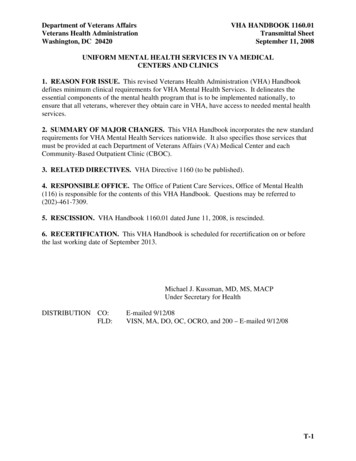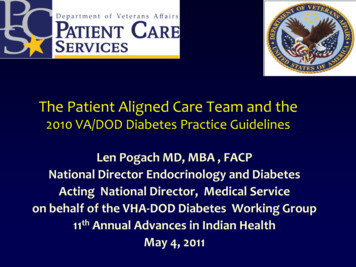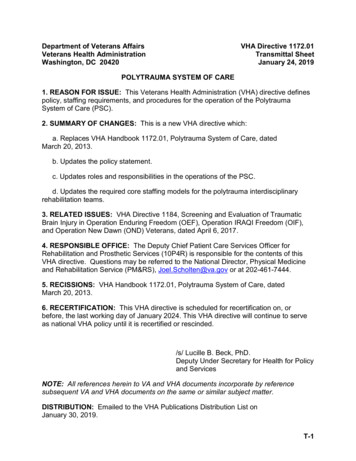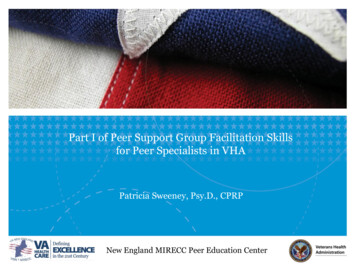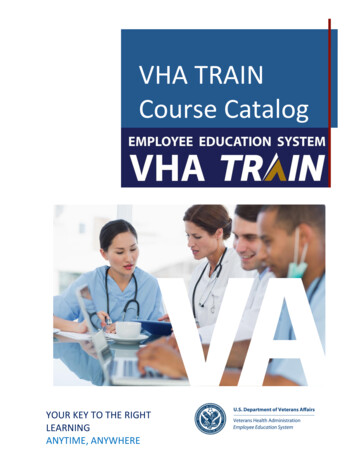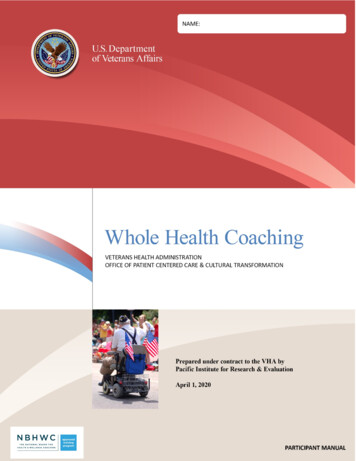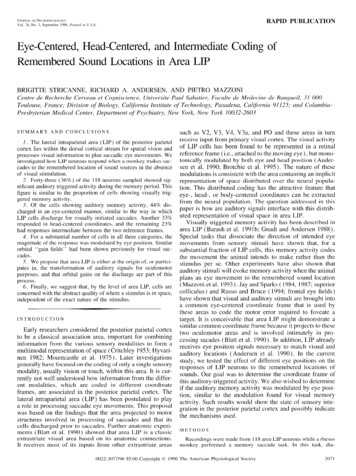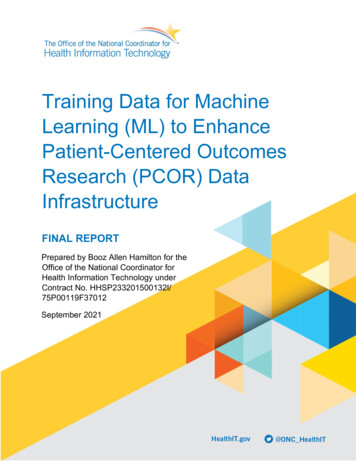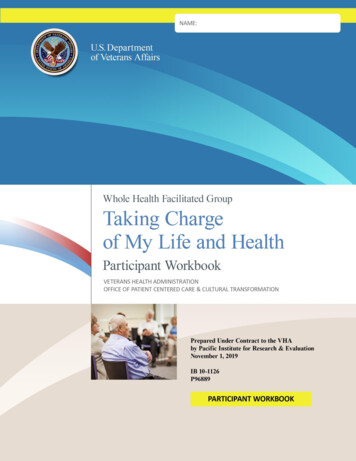
Transcription
TAKING CHARGE OF MY LIFE AND HEALTH—PARTICIPANT WORKBOOKVHA /Office of Patient Centered Care & Cultural Transformation –revised August 1, 2019 i
WHOLE HEALTH IN YOUR LIFE AND PRACTICE—PARTICIPANT WORKBOOKii VHA /Office of Patient Centered Care & Cultural Transformation – revised August 1, 2019
TAKING CHARGE OF MY LIFE AND HEALTH—PARTICIPANT WORKBOOKTABLE OF CONTENTSSESSION 1 . 5THE COMPONENTS OF PROACTIVE HEALTH AND WELL-BEING . 5YOUR PERSONAL HEALTH INVENTORY (PHI) . 6GROUP GUIDELINES . 11MINDFUL MOMENTS . 13THE NINE ATTITUDES OF MINDFULNESS . 15SESSION 2 . 16VALUES-CONFLICT WORKSHEET . 16SESSION 3 . 18SMART GOAL AND ACTION STEPS WORKSHEET. 18BARRIERS WORKSHEET . 19SMART GOAL AND ACTION STEPS WORKSHEET. 20BARRIERS WORKSHEET . 21SMART GOAL AND ACTION STEPS WORKSHEET. 22BARRIERS WORKSHEET . 23SESSION 4 . 24POSSIBLE FOOD AND DRINK CHOICES . 24POWER OF THE MIND . 25SESSION 5 . 26FAMILY, FRIENDS, AND CO-WORKERS – IDEAS TO CONSIDER . 26SURROUNDINGS . 27SESSION 6 . 28MOVING YOUR BODY – SOME IDEAS TO CONSIDER . 28RECHARGE – SOME IDEAS TO CONSIDER . 29SESSION 7 . 30SPIRIT AND SOUL . 30CHOICES: PERSONAL DEVELOPMENT . 31SESSION 8 . 32PARTNERING WITH YOUR PHYSICIAN . 32VHA /Office of Patient Centered Care & Cultural Transformation –revised August 1, 2019 iii
WHOLE HEALTH IN YOUR LIFE AND PRACTICE—PARTICIPANT WORKBOOKMY OWN PERSONALIZED HEALTH PLAN . 33SESSION 9 . 36APPENDIX . 384 STAGE PROCESS MODEL FOR GROUP FACILITATION . 40FIVE SIGNS OF SUFFERING . 42iv VHA /Office of Patient Centered Care & Cultural Transformation – revised August 1, 2019
TAKING CHARGE OF MY LIFE AND HEALTH—PARTICIPANT WORKBOOKSESSION 1THE COMPONENTS OF PROACTIVE HEALTH AND WELL-BEINGVHA /Office of Patient Centered Care & Cultural Transformation –revised August 1, 2019 5
TAKING CHARGE OF MY LIFE AND HEALTH—PARTICIPANT WORKBOOKYOUR PERSONAL HEALTH INVENTORY (PHI)1. What is my Mission, Aspiration or Purpose (MAP) in life?2. What REALLY matters to you in your life?3. What brings you a sense of joy and happiness?4. On the following scales from 1-5, with 1 being miserable and 5 being great, circle where youfeel you are on the scale.Physical Well-Being:1234Miserable5GreatMental/Emotional Well-Being:1234Miserable5GreatLife: How is it to live your day-to-day life?1234Miserable6 VHA /Office of Patient Centered Care & Cultural Transformation – revised August 1, 20195Great
TAKING CHARGE OF MY LIFE AND HEALTH—PARTICIPANT WORKBOOKWHERE YOU ARE AND WHERE YOU WOULD LIKE TO BEFor each area below, consider where you are now and where you would like to be. All the areasare important. In the “Where you are” box, briefly write the reasons you chose your number. Inthe “Where you want to be” box, write down some changes that might make this area better foryou. Some areas are strongly connected to other areas, so you may notice some of your answersseem the same. Try to fill out as many areas as you can. You do not have to write in every area orin all the areas at one time. You might want to start with the easier ones and come back to theharder ones. It is OK just to circle the numbers.Moving the Body: “Energy and Flexibility” Includes movement and physical activities like walking,dancing, gardening, sports, lifting weights, yoga, cycling, swimming, and working out in a gym.Where you are: Rate yourself on a scale of 1 (low) to 5 (high)Where would you like to be?112345What are the reasons you choose this number?2345What changes could you make to help you get there?Recharge: “Sleep and Refresh” Getting enough rest, relaxation, and sleep.Where you are: Rate yourself on a scale of 1 (low) to 5 (high)Where would you like to be?11234What are the reasons you choose this number?52345What changes could you make to help you get there?VHA /Office of Patient Centered Care & Cultural Transformation –revised August 1, 2019 7
TAKING CHARGE OF MY LIFE AND HEALTH—PARTICIPANT WORKBOOKFood and Drink: “Nourish and Fuel” Eating healthy, balanced meals with plenty of fruits and vegetableseach day. Drinking enough water and limiting sodas, sweetened drinks, and alcohol.Where you are: Rate yourself on a scale of 1 (low) to 5 (high)Where would you like to be?112345What are the reasons you choose this number?2345What changes could you make to help you get there?Personal Development: “Personal life and Work life” Learning and growing. Developing abilities andtalents. Balancing responsibilities where you live, volunteer, and work.Where you are: Rate yourself on a scale of 1 (low) to 5 (high)Where would you like to be?112345What are the reasons you choose this number?2345What changes could you make to help you get there?Family, Friends, and Co-Workers: “Relationships” Feeling listened to and connected to people you loveand care about. The quality of your communication with family, friends and people you work with.Where you are: Rate yourself on a scale of 1 (low) to 5 (high)Where would you like to be?11234What are the reasons you choose this number?5234What changes could you make to help you get there?8 VHA /Office of Patient Centered Care & Cultural Transformation – revised August 1, 20195
TAKING CHARGE OF MY LIFE AND HEALTH—PARTICIPANT WORKBOOKSpirit and Soul: “Growing and Connecting” Having a sense of purpose and meaning in your life. Feelingconnected to something larger than yourself. Finding strength in difficult times.Where you are: Rate yourself on a scale of 1 (low) to 5 (high)Where would you like to be?112345What are the reasons you choose this number?2345What changes could you make to help you get there?Surroundings: “Physical and Emotional” Feeling safe. Having comfortable, healthy spaces where you workand live. The quality of the lighting, color, air, and water. Decreasing unpleasant clutter, noises, and smells.Where you are: Rate yourself on a scale of 1 (low) to 5 (high)Where would you like to be?112345What are the reasons you choose this number?2345What changes could you make to help you get there?Power of the Mind: “Strengthen and Listen” Tapping into the power of your mind to heal and cope.Using mind-body techniques like relaxation, breathing, or guided imagery.Where you are: Rate yourself on a scale of 1 (low) to 5 (high)Where would you like to be?11234What are the reasons you choose this number?52345What changes could you make to help you get there?VHA /Office of Patient Centered Care & Cultural Transformation –revised August 1, 2019 9
TAKING CHARGE OF MY LIFE AND HEALTH—PARTICIPANT WORKBOOKPROFESSIONAL CAREPrevention: On a scale of 1-5, circle the number that best describes how up to date you are on yourpreventive care such as a flu shot, cholesterol check, cancer screening, and dental care.12Not at allA little bit3Somewhat4Quite a bit5Very muchClinical Care: If you are working with a healthcare professional, on a scale of 1-5, circle thenumber that best describes how well you understand your health problems, the treatment plan, andyour role in your health.12Not at allA little bit3Somewhat4Quite a bitI am not working with a healthcare professional.REFLECTIONS1. Now that you have thought about all of these areas, what is your vision of your best possiblehealth? What would your life look like? What kind of activities would you be doing?2. Are there any areas you would like to work on? Where might you start?10 VHA /Office of Patient Centered Care & Cultural Transformation – revised August 1, 20195Very much
TAKING CHARGE OF MY LIFE AND HEALTH—PARTICIPANT WORKBOOKGROUP GUIDELINES Honor confidentialityMaintaining every group member’s confidentiality is a key part of the Whole HealthFacilitated Group Program. Everyone needs to feel safe and trust that what happens in thegroup stays in the group. This means not sharing what you hear in the group with anyoneoutside the group. It also means that if you see another group member in the hallway, youwon’t ask them how they’re doing on group-related activities. You should obviously feelfree to share any of your own learning experiences throughout the program to anyone atany time. But you should do so without talking about others in the group. Speak honestlyEach session will involve some discussion, practices, and some paired activities. Youractive participation will help you to get as much as possible out of this group, and yourhonesty, with yourself and the other members of the group, will support that. Respectful listeningRespectful listening means: Listening with an open mind and an open heart Letting everyone have a turn speaking Not interrupting each other Not giving advice, but rather Letting each group member come to his or her own answers Respect differences – we are not all going to agree and that is okay Start and finish on timeWe all have various responsibilities and time commitments beyond this group. I want torespect your time and the other commitments you have. I will make every effort to beginand end each session on time. This means I will begin at the scheduled time (STATETIME) even if not everyone is present, and I will end at (STATE TIME). It can bedisrupting to have someone enter or leave when you are speaking or in the middle of anexercise. Please respect your fellow group members by arriving on time for every sessionand remaining until the session is complete. Turn off your personal electronic devices (phone, PDA, pager, etc.)Unexpected beeps, rings, and other noises are distracting and take away from the learningenvironment. Please turn off your cell phone, PDA, pager or other electronic devicesduring sessions. If there are issues for which you need to leave your phone on vibrate,please let me know and step outside to take any calls. Additional guidelines added by the groupVHA /Office of Patient Centered Care & Cultural Transformation –revised August 1, 2019 11
TAKING CHARGE OF MY LIFE AND HEALTH—PARTICIPANT WORKBOOK12 VHA /Office of Patient Centered Care & Cultural Transformation – revised August 1, 2019
TAKING CHARGE OF MY LIFE AND HEALTH—PARTICIPANT WORKBOOKMINDFUL MOMENTSBelow are some easy ways to add “mindful moments” into your daily routine.1. Mindful Awareness While Brushing Your TeethThe Old Way: Not paying close attention when you pick up your toothbrush and move it aroundyour mouth. On autopilot, as you brush and walk through your house, trip over the cat, look foryour keys, get ready for your first meeting of the day, and think about where you’ll get lunchtoday.The New Way: Notice what it feels like to have your feet on the floor, how hot or cold it feels,what the carpet or tile or wood feels like on the soles of your feet; paying attention to the feel ofthe toothpaste in your mouth and on your teeth. Notice the smell, the flavor, the grit. Notice howyour arm moves from side to side and the sound of the brush against your teeth, being aware ofhow the brush feels on every tooth and on your gums.Bonus: Not only will you feel calm and collected afterward, your dentist will be happy with you,too!2. Mindful Awareness While Taking a ShowerThe Old Way: Turn on the water and hop in. Wash your hair and body while making plans forthe day. Think about the big sports game that night, as you sing your favorite tune into theshowerhead.The New Way: Paying attention as your hands turn the faucet. Being mindful of the need to setthe temperature before getting into the shower; mindful of the feeling as the warm water washesover you; aware of the smell of the shower gel, soap or shampoo; noticing the mind racing,imagining conversations that have yet to happen; mindful of the amount of water you’re using;and mindful of the sound of the water coming to a stop.Bonus: You’ll end up with a much clearer mind for the day ahead.3. Mindful Awareness While Commuting to WorkThe Old Way: Standing and feeling crowded on a train or bus, wishing you had a seat, thinkingabout the day ahead of you, or sitting in your car and being frustrated in bumper-to-bumpertraffic.The New Way: Being mindful of your environment and noticing details of your commute;noticing the emotions as they rise and fall, come and go; aware of all the different senses. Thesights, sounds, and smells of your commute, but rather than thinking about them, judging them,just notice them; mindful of wanting to be somewhere else, of wishing time away; and mindfulof wanting to scream out loud or put your foot down in the car.Bonus: You will probably be a safer, calmer driver. You might even show up to work with asmile on your face.VHA /Office of Patient Centered Care & Cultural Transformation –revised August 1, 2019 13
TAKING CHARGE OF MY LIFE AND HEALTH—PARTICIPANT WORKBOOK4. Mindfulness While Washing the DishesThe Old Way: Trying to avoid the sharp knife, hidden beneath the plates in the water, as youstare out of the window and think about the mess in the living room you need to clean up, or thebig meeting at work the next day.The New Way: Being mindful of the very first moment when your hands meet the water; feelingthe warmth; mindful of picking up one thing at a time and taking just an extra second or two toclean it; aware of the passing thoughts and of letting them go; mindful of seeing people comeand go through the window without judgment or attachment; mindful of wanting to get on and dosomething else; and mindful of feeling satisfied when you’ve finished.Bonus: OK, so you might have a dishwasher, but you get the picture. And if the dishwasher everbreaks down, you’ll know that it is possible to practice mindfulness while washing the dishes.5. Mindfulness While Waiting in LineThe Old Way: As you stand there tapping your foot, arms crossed and jaws clenched, youwonder why everyone else has chosen the exact same time as you to come to the bank. As youcheck your phone, searching for something, anything, to do to escape your own impatience.The New Way: Being mindful of the rush that you are in when you enter the bank; aware of howyou respond when you first see the line; mindful of how you stand there waiting; mindful of yourbreath as you focus on the physical sensations in the body; noticing your response each time theline creeps forward; mindful of the tendency to keep looking at your watch, or checking yourphone; mindful and present for your conversation with another human being when you finallyget served.Bonus: You can see the line as an irritating inconvenience, or as time to take a break.14 VHA /Office of Patient Centered Care & Cultural Transformation – revised August 1, 2019
TAKING CHARGE OF MY LIFE AND HEALTH—PARTICIPANT WORKBOOKTHE NINE ATTITUDES OF MINDFULNESS(Full Catastrophe Living by Jon Kabat-Zinn) Beginner’s Mind—As a coach, being curious and not assuming that you already know something.Asking questions and being excited about how your mind works, asking questions like: Who isseeing? Who is thinking?Non-judging—A gentle state of non-judgment, being kind to yourself, and allowing what is.Trying not to compare, label, or find fault.Patience—Let things happen as they need to and in their own time. Letting go of the idea that youhave to “get somewhere, do something, or make something happen.”Non-striving - Mindful awareness is about being, not doing, if it feels like you’re working toohard you probably are. It’s a way of being, being awake to what is happening in your life ratherthan what is happening in your mind.Acceptance- Seeing things as they are. It is what it is. Try to be with things as they are. Let go ofthe stories the mind creates and accept the present moment for what it is.Letting go—Not having a set agenda for what “should” happen. Being open to all possibilitiesand outcomes.Trust—As awareness grows, so does trust in one’s emotions and intuition; be yourself in everyway. Have faith in how you move through the world. Trust yourself and what you know.Gratitude – The ability to bring gratitude to the present moment, not taking things, even thesmallest of things, for granted.Generosity – The power of giving yourself over to life, to bring joy to others’ lives. Giving yourtime and attention to life and others enhances interconnectedness and demonstrates that you care.VHA /Office of Patient Centered Care & Cultural Transformation –revised August 1, 2019 15
TAKING CHARGE OF MY LIFE AND HEALTH—PARTICIPANT WORKBOOKSESSION 2VALUES-CONFLICT WORKSHEETValues Anything that is important to usIdeal Values those values that are important to us in the long runOperational Values those values that are important to us in the momentSome examples might be: My value of health vs eating a second piece of pie;My value of relationship with family vs spending the weekend fishing;My value of Integrity vs telling a little ‘white’ lie;My value of saving for my retirement vs having a fancy new car;My value of getting rest vs staying up for one more TV showDescribe a situation where your behaviors were not totally consistent with your highestvalues:What two values were in conflict?Value 1:Value 2:What did I gain from the behaviors I did?What did I not gain?What value was I honoring the most at that moment?16 VHA /Office of Patient Centered Care & Cultural Transformation – revised August 1, 2019
TAKING CHARGE OF MY LIFE AND HEALTH—PARTICIPANT WORKBOOKIn the future, is there a way you might honor both values?Is one value more important than the other? If yes, describe how.VHA /Office of Patient Centered Care & Cultural Transformation –revised August 1, 2019 17
TAKING CHARGE OF MY LIFE AND HEALTH—PARTICIPANT WORKBOOKSESSION 3SMART GOAL AND ACTION STEPS WORKSHEETArea of FocusWhat outcome would I like to achieve?(Examples include: Lose weight, reduce stress, improve my relationships, look better, get another job,have more energy.)Timeframe (circle one) 3 months 6 months OtherSMART Goal and Action Steps Criteria Specific—clear and concise Measurable—clear way for knowing if the goal is met Action-Oriented—action that is in direct control of the person Realistic—based on what is possible or the person thinks they can do Timed—contains a time line for steps along the way to the final goalGoal:Action Steps:Action Steps are steps that help you work toward your goal that (1) can be done in the following week ortwo and (2) meet the same SMART criteria. Action steps can be planned out over time or made after thefirst week’s action steps are attempted.Action Step 1Action Step 2 (Optional)Action Step 3 (Optional)Who is going to help make sure I do my action steps? (Accountability)18 VHA /Office of Patient Centered Care & Cultural Transformation – revised August 1, 2019
TAKING CHARGE OF MY LIFE AND HEALTH—PARTICIPANT WORKBOOKBARRIERS WORKSHEETThere will be different challenges to completing your action steps and larger health goals, andyou will need to find ways to work around these barriers.Internal barriers:When you do not have the knowledge or skills to make a change, or when negative beliefs aboutyourself get in the way.Interpersonal barriers:When our roles in, and responsibilities to, family, work, friends, and the community get in theway of us doing our action steps and meeting our goals.External barriers:When things outside of our control (i.e. money, weather events, or an injury) get in the way.What are some barriers that you may encounter and what will be your strategy, or back-up plan,for success?For example, do you need to work out family or work agreements to support your goals?What will you do if there is bad weather, family vacations, parties and events that interrupt yourschedule?Barrier 1:Strategies/Back-up Plan:Barrier 2:Strategies/Back-up Plan:Barrier 3:Strategies/Back-up Plan:VHA /Office of Patient Centered Care & Cultural Transformation –revised August 1, 2019 19
TAKING CHARGE OF MY LIFE AND HEALTH—PARTICIPANT WORKBOOKSMART GOAL AND ACTION STEPS WORKSHEETArea of FocusWhat outcome would I like to achieve?(Examples include: Lose weight, reduce stress, improve my relationships, look better, get another job,have more energy.)Timeframe (circle one) 3 months 6 months OtherSMART Goal and Action Steps Criteria Specific—clear and concise Measurable—clear way for knowing if the goal is met Action-Oriented—action that is in direct control of the person Realistic—based on what is possible or the person thinks they can do Timed—contains a time line for steps along the way to the final goalGoal:Action Steps:Action steps are steps that help you work toward your goal that (1) can be done in the following week ortwo and (2) meet the same SMART criteria. Action steps can be planned out over time or made after thefirst week’s action steps are attempted.Action Step 1Action Step 2 (Optional)Action Step 3 (Optional)Who is going to help make sure I do my action steps? (Accountability)20 VHA /Office of Patient Centered Care & Cultural Transformation – revised August 1, 2019
TAKING CHARGE OF MY LIFE AND HEALTH—PARTICIPANT WORKBOOKBARRIERS WORKSHEETThere will be different challenges to completing your action steps and larger health goals, andyou will need to find ways to work around these barriers.Internal barriers:When you do not have the knowledge or skills to make a change, or when negative beliefs aboutyourself get in the way.Interpersonal barriers:When our roles in, and responsibilities to, family, work, friends, and the community get in theway of us doing our action steps and meeting our goals.External barriers:When things outside of our control (i.e. money, weather events, or an injury) get in the way.What are some barriers that you may encounter and what will be your strategy, or back-up plan,for success?For example, do you need to work out family or work agreements to support your goals?What will you do if there is bad weather, family vacations, parties and events that interrupt yourschedule?Barrier 1:Strategies/Back-up Plan:Barrier 2:Strategies/Back-up Plan:Barrier 3:Strategies/Back-up Plan:VHA /Office of Patient Centered Care & Cultural Transformation –revised August 1, 2019 21
TAKING CHARGE OF MY LIFE AND HEALTH—PARTICIPANT WORKBOOKSMART GOAL AND ACTION STEPS WORKSHEETArea of FocusWhat outcome would I like to achieve?(Examples include: Lose weight, reduce stress, improve my relationships, look better, get another job,have more energy.)Timeframe (circle one) 3 months 6 months OtherSMART Goal and Action Steps Criteria Specific—clear and concise Measurable—clear way for knowing if the goal is met Action-Oriented—action that is in direct control of the person Realistic—based on what is possible or the person thinks they can do Timed—contains a time line for steps along the way to the final goalGoal:Action Steps:Action steps are steps that help you work toward your goal that (1) can be done in the following week ortwo and (2) meet the same SMART criteria. Action steps can be planned out over time or made after thefirst week’s action steps are attempted.Action Step 1Action Step 2 (Optional)Action Step 3 (Optional)Who is going to help make sure I do my action steps? (Accountability)22 VHA /Office of Patient Centered Care & Cultural Transformation – revised August 1, 2019
TAKING CHARGE OF MY LIFE AND HEALTH—PARTICIPANT WORKBOOKBARRIERS WORKSHEETThere will be different challenges to completing your action steps and larger health goals, andyou will need to find ways to work around these barriers.Internal barriers:When you do not have the knowledge or skills to make a change, or when negative beliefs aboutyourself get in the way.Interpersonal barriers:When our roles in, and responsibilities to, family, work, friends, and the community get in theway of us doing our action steps and meeting our goals.External barriers:When things outside of our control (i.e. money, weather events, or an injury) get in the way.What are some barriers that you may encounter and what will be your strategy, or back-up plan,for success?For example, do you need to work out family or work agreements to support your goals?What will you do if there is bad weather, family vacations, parties and events that interrupt yourschedule?Barrier 1:Strategies/Back-up Plan:Barrier 2:Strategies/Back-up Plan:Barrier 3:Strategies/Back-up Plan:VHA /Office of Patient Centered Care & Cultural Transformation –revised August 1, 2019 23
TAKING CHARGE OF MY LIFE AND HEALTH—PARTICIPANT WORKBOOKSESSION 4POSSIBLE FOOD AND DRINK CHOICESYou may want to consider the following when enhancing your health through food anddrink choices:I eat because: I’m bored Others are eating I’m hungry I’m stressed Out of habit OtherYou may want to change your food and drink intake to impact: Mood Energy level Weight Sense of pain Quality and length of life Allergies OtherYou may want to consider reducing: Sugar Salt Processed Foods Sugary drinks such as sodas and fruit juice Red meats Alcohol, tobacco or other drug use Amount of food intake OtherYou may want to consider adding: More fruits and/or vegetables Real food, unprocessed More water More whole grains OtherNote: These are general guidelines. Before making major changes please consult with yourphysician or nutritionist.24 VHA /Office of Patient Centered Care & Cultural Transformation – revised August 1, 2019
TAKING CHARGE OF MY LIFE AND HEALTH—PARTICIPANT WORKBOOKPOWER OF THE MINDYou may want to consider the following when thinking about your health through thepower of your mind:Why would you want to enhance the power of your mind? Reduce stress in my life and relax a little more Think more positively about my life and relationships Have more courage to try new things Reduce my focus on negative things Improve how I feel in my body and mind OtherYou might want to decide if there is a mind-body approach that you would like to try.These may be available in your VA or in your community. Psychological approaches including hypnosis, imagery, biofeedback and CognitiveBehavioral Therapy (CBT) Art Therapies including painting, music, dance or other forms of creativity Breathing Exercises Journaling may be helpful in being mindful about your day-to-day life Meditation and/or mindful awareness. There are many types. Progressive Muscle Relaxation (PMR) and Progressive Relaxation (PR) Yoga, Tai Chi or other movement activities that include a mind componentYou might consider increasing the power of your mind through some of the following: First, recognize that I have a choice about how I want to view my life and the world Second, recognize that how I view my life has an impact on my health and well-being Choose one of the therapies above and work with a professional to practice it Think about what causes you stress and what you can do to best manage that stress Pay attention to your emotions. How often do you feel angry, sad, happy or at ease? Keep your mind active with puzzles, reading or other creative outletsNote: These are general guidelines. Before making major changes, please co
TAKING CHARGE OF MY LIFE AND HEALTH—PARTICIPANT WORKBOOK 6 VHA /Office of Patient Centered Care & Cultural Transformation – revised August 1, 2019 YOUR PERSONAL HEALTH INVENTORY (PHI) 1. What is my Mission, Aspiration or Purpose (MAP) in life? 2. What REALLY matters to you in your life? 3. What bri

